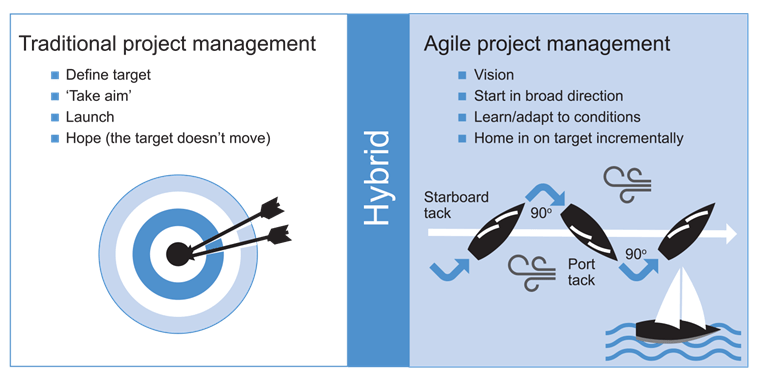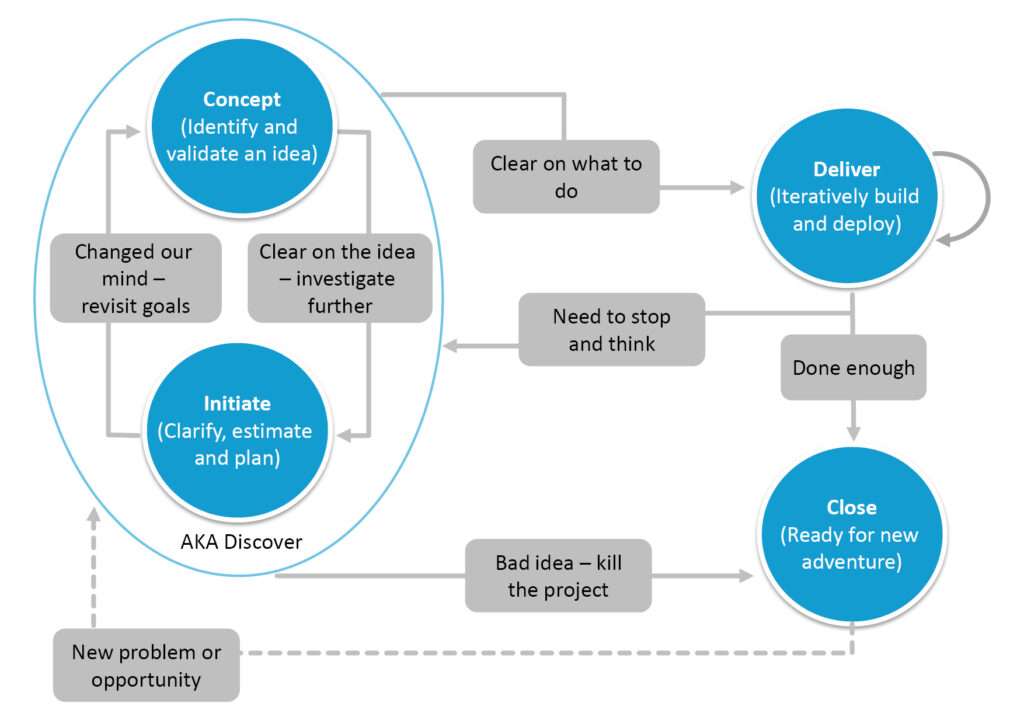Ok let us take look at the 5th snippet sharing session and this time around it is about AGILITY. This is a term that is a hot favourite out there by companies who now realise that those familiar with the agility concept will be better employee than those who do not. Also in business, those who practiced agility management would be better than those who do not. So what is it? Agility comes from the root word agile, which simply means flexible or adaptable.
Aglity nowadays comes in many forms but the most popular ‘pattern’ is in project management (so take note that there are also agile ideas development, agile marketing etc etc). The moment the word agile is there it means that the approach taken differs. Using the photo of the difference between Traditional Project Management (or just project management) vs Agile Project Management. In normal project management, everything will look ‘fixed’. The goals or objectives are detailed out and you work towards it. Imagine you are on the road towards your destination, you will focus on the route to get there because you sole purpose is to reach the destination at the given time. You will not look left or right or consider alternative routes. You are focused and single-minded. You are completely tasked focus. The end is everything.
Now what is different with agile project management is that you have the big picture, the vision, the broad idea. So from the very start, you are already empowered to think differently from the other members of the team (remember in a specific goal, very likely all team members think the same as the thought process is governed by strict guidelines). So given the big picture broader vision, everyone in the team starts with a higher level of creativity on how to reach the destination. It is no longer a specific route. Using the example just now, for agile project management we can now consider reaching our destination using land, air, and sea, using various forms of vehicles, considering the best route among the various alternatives. This is the difference and of course for someone using agile techniques, the outcome or end result would be the best out of the best, no longer a matter of reaching it (its reaching it in the best possible manner).
Agile project management gives emphasis on using available resources in the best way possible. It is not just restricted to team members of project management (for traditional) but it can also involve the use of expertise outside the team. Agile project management takes into account different and varying conditions ie even distractors are considered. Hence the team that reaches the goal in agile project management will do so with better quality than the team that uses traditional project management.
The simple ‘moral of the story’ in this learning is being flexible and adaptable. Because we all know that things do usually go as plan. If you are familiar with the concept of Murphy’s Law (which means if there are possibilities of things going wrong, they will go wrong). This is the reason why traditional project management is no longer preferred. Should something goes wrong especially towards the end of the project goal, there is a high probability that the problem may not be resolved. A restart is required. But in agile project management, since flexibility and adaptability is practiced from the beginning, a new challenge at whatever juncture is something that can be overcome.
Likewise in Agile Marketing (vs Traditional Marketing of say the 4Ps – Place, Promotion, Price and Product), agile marketing will look into many other factors on top of the 4Ps. Agile will have more Ps and may also include some Cs eg customer experience. So in agile marketing, members will consider not just who, what, here and how much, but will also take into account the experience. How does the customer feels when they are in contact of the brand, how do they feel when they walk into the store, what will they see or smell while waiting in the cashier queue, what is their impression when they walked out of the store etc. All these factors are not considered in the traditional marketing application. They are in agile marketing. If you are the owner of a business, you will want agilie marketing to be in place because you can be assured that it is not just a matter of attending to a customer’s need but also making the customer so impressed that you will the customer’s loyalty (not to mention the customer becoming a product ambassador as the customer will be talking to his/her friends of the details that you put in.
A Chinese restaurant in Singapore is now the talk of the town because of the way they serve the customers. Unlike any other restaurant, this restaurant thinks about every possible way to impress the customer eg while waiting for the food, they will clean your handphone for you (all other restaurants won’t even bother to tell you that your food will be served late due to the crowd). So despite this particular Chinese restaurant is known to be pricey, the queue is always long because people want to experience being treated as Kings and Queens and not just customers.
Moving forward, in whatever that you do, adopt agility in it. be flexible, be adaptable and be different. Because to survive in today’s environment, covid or not, you cannot be like anybody else because any good area will soon become very competitive. Eg if you say that you open a satay stall at X place and its booming, in less than 2 weeks, 9 other new satay stalls will open beside you. And you will become just one of the 10. But if you adopt agile marketing, you will unbeatable simply because you are different, you give more, and you surprise your customers.
So remember…adopt agility in whatever you do. It doesn’t mean that you start with a vision you will take a longer time to reach your destination than someone who started with a specific goal in mind. In fact, you might even complete your assignment faster because you are able to take into account all the factors affecting your work and work with the best. In traditional marketing the risk is higher especially when you have trained your mind on a fixed way and then the target moves near the end.
Make it a personal habit in whatever you do, even in Asentar. Be agile. Do not just follow the one path (that path everybody is using despite that being a tried and tested or success-proven path). Be creative, be open-minded, be exploratory, be adaptable, be flexible, be brave. So I hope that you have learned a thing or two about what agility is all about. This is a snippet sharing so I can’t deep dive into it but enough to give you an idea of what it is and how to use it. If you are interested there are many institutions out there now that offer courses on agility and the cert can be helpful to make you more ‘valuable’ than someone who do not possess that qualification.


